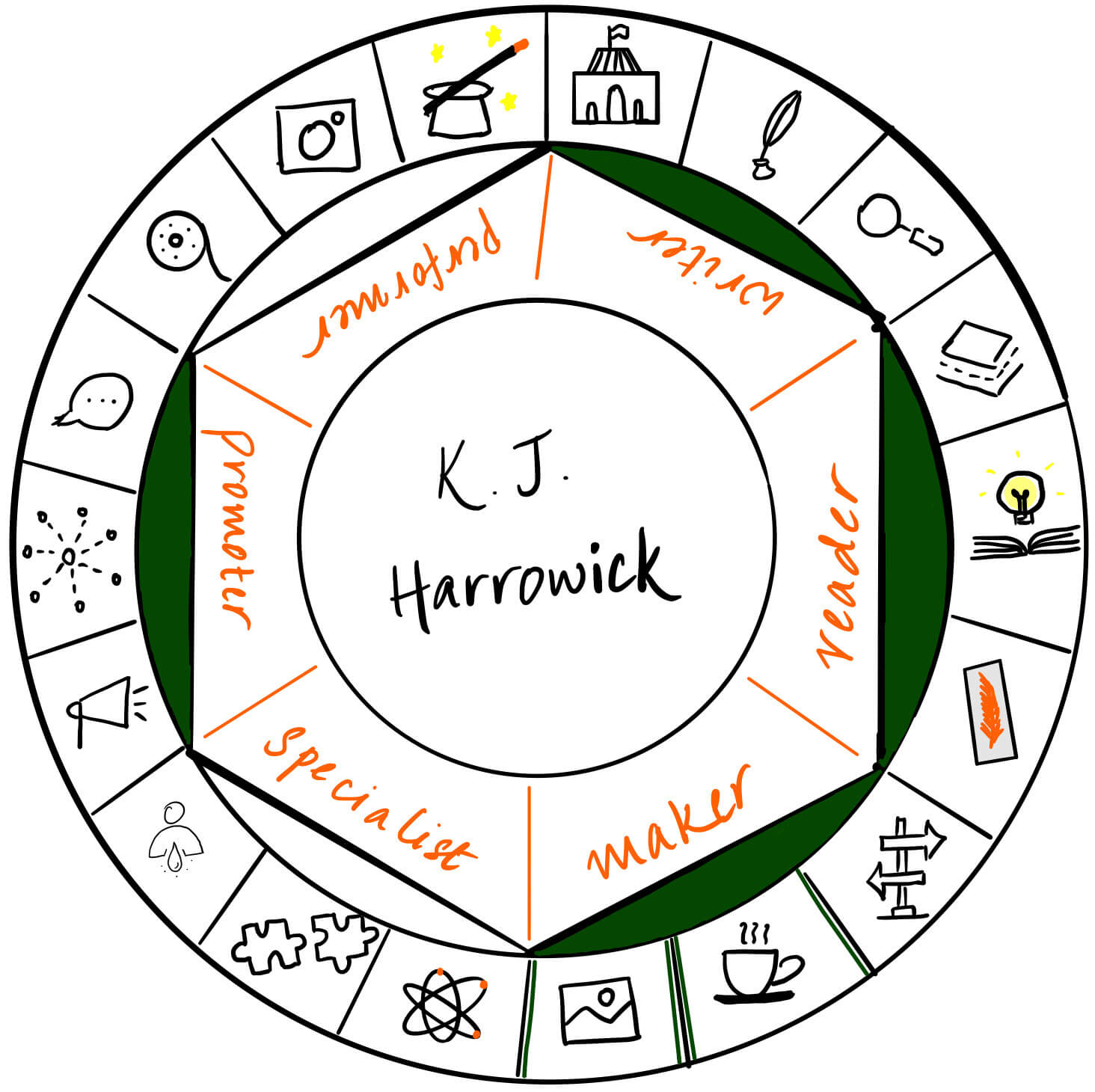
What does the phrase ‘writing community’ bring to your mind? I have been an active member of the twitter writing community for almost a year now and my experience so far has been that it has connected me with not only authors, but also fellow book bloggers, readers and more. Though most of the posts in the community revolve around promotion of the works and writing, I have always wondered what a true writing community, where people knew each other and engaged more frequently looks like.
I’m thrilled to invite K. J. Harrowick to The Creator’s Roulette today to learn more about her and such communities. K. J. Harrowick is a freelance developer and graphic designer with a strong love for dark fantasy books—the more twisted the better!
On The Importance of Writing Communities
K.J. , why are communities important to you?
Thanks for having me!
I think to understand why communities are so important, one has to take a closer look into what a writer’s life might look like from the inside. Mileage will vary, but here are a few truths my experience has uncovered.
1. Writing is a lonely road. When we set out to draft a story, a relationship forms between the writer and the characters we’re weaving into our world. We become creators, therapists, and enablers to craft conflict and emotion through the narrative, and inevitably we fall in love with this creation. But like all strong relationships, love can have blind spots.
2. Writing is a frustrating road. Each writer has skills and struggles, and through these we attempt to employ methods to help the process become smoother, many times cutting corners so that ‘done’ feeling morphs into a sense of accomplishment. But then something’s not right. We’ll reread our work, make fixes, and yet there’s an imbalance to the work we can’t quite put a finger on.
3. Writing is an emotional road. Each stage, from drafting to revision to launching a new book comes with its own set of problems. We begin fighting the process, fighting ourselves, and sometimes all we can do is let go of a project and grieve because so much time and effort has placed us in a dark corner with no visible way out.
This is where communities become such an important resource for writers of every level. In a community, writers can brainstorm their projects and struggles, often gaining insight from other trusted members. It’s where they’ll find new tools, tips and tricks to hone their craft, and emotional support for the days when chucking the laptop out the window feels like the last option left.
And when love is blind—or in this case, blindness to the problems in a story—communities of critique partners will help a writer to pinpoint where the story is falling apart and strategize ways to rework the elements for a stronger, more engaging narrative.
What Writing Communities Look Like

You have done a lot of work in the writer community in the past year. What does such a community look like and what kind of work do you do there?
This really comes down to the community. Each one is unique and creates a focus to help writers in a specific way, so here are some examples from some of my favorite communities.
1. The private critique group – a space like this might have anywhere from three to thirty people who work together on Slack, Discord, Facebook, or Twitter DM. These writers brainstorm their stories and talk about plot holes, character motivations, and all the ‘but why?’ questions to help a writer uncork the deepest parts of their story. This group also shares queries, synoses, book jackets, chapters, pitches – all the elements that need a deep, thorough critique to help the writer’s story strengthen and shine.
2. The public craft element group – often found on Twitter hashtags, these groups create a space to chat about specific elements of a story. #WIPWorldBuilders creates a daily question, and writers engage by sharing how that question is answered for their story. Both #WineAndWrite and #RewriteItClub create monthly chats for writers to share more about their process of both writing and self-care. Then there are bigger contest communities like #RevPit and #AMM (author mentor match) who bring professionals and newer writers together in a partnership to help bring stories to the next level.
Communities are a wonderful resource and I encourage all writers to source a few out and see what spaces fit their needs in a healthy, engaging way.
Engaging all Writers in Writing Communities
What about writers who do not write novels or stories? How can they become part of such communities, or would they be different communities?
There’s an entire spectrum of writers out there. While I primarily work with fiction novelists, there are also memoir and non-fiction writers, journalists, articles, blogging, even smaller, high-impact craft for copywriting and marketing.
But we’re all writers, and we all cross each other’s paths. My thought here is that some of these folks have communities that cater specifically to them and provide a space of support and encouragement while tackling their craft with different methods. Think AP editorial style for online journals vs Chicago style for novels.
On Growing with Feedback

Critique, and feedback helps us grow and get better. But acknowledgement of good work is also important to keep one going on the path they are on. How do these three elements get balanced in a community of writers?
Balance is key when it comes to critique, and a really great one will provide insightful feedback on why a sentence, chapter, plot point, or even a character simply isn’t working, and it will point out elements of a story that really nail a beat, make the reader laugh out loud, or provide an element of delight.
When a writer works with a community of trusted peers, the critique becomes many points of view. It allows the author a chance to see deeper into their story—one reader might love the opening line while another finds it clunky and jarring. Maybe two readers don’t connect with the main character, but the other three loved her.
So not only can one reader provide a well-balanced critique, but a community of readers can offer multiple perspectives and balance the writer’s understanding of their story, writing style, character development, world building, and sensory emotion.
On Personal Preferences
Everyone has preferences for the kind of material they like to read. What role do personal preferences play in communities?
Again, this ties back to the type of community the writer is working with. Personal reading preferences and an understanding of one’s emotional health are key to helping a writer understand which communities will benefit them (and their work) the most.
One of the ways a writer can help themselves to understand both what they need and where they can be most helpful is to read widely and review everything. Reading will help a writer understand different writing styles, storytelling tactics, and elements they either love or loathe in a great book. And reviewing (even just a line or two) will help writers learn strategies and methods for critique, ways to help another writer without tearing them down.
As a writer gains a stronger understanding of their personal preferences, they’ll be able to see which communities are the most beneficial for them and their work, and which communities they can offer the most aid to help strengthen and connect with other writers.
But no writer should overlook self-care. Personal needs and emotional health are just as important as writer craft. It’s why not every community will be one size fits all, and every writer should carry a sense of awareness with them in every space to find the best fit.
Looking for K.J. and some writing communities to join?
K. J. is the co-creator of Rewrite It Club and Writer In Motion, creator of Winterviews, and has an unhealthy obsession with falling down rabbit holes. You can follow her blog, or connect with her on Twitter, Facebook, Instagram and Pinterest.


Cover Photo by Plush Design Studio on Unsplash
Photo with quote by hannah grace on Unsplash

Thank you for such a wonderful time! <3